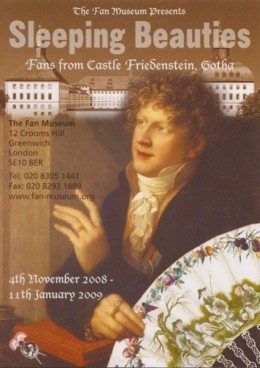
Like the Sleeping Beauty, a unique collection of fans collected by Duke Augustus of Saxe-Gotha-Altenburg in the early 19th century has long lain dormant at Schloss Friedenstein in Gotha, East Germany. Thanks to the initiative of a number of fan lovers and, in particular, Frau Däberitz, the Curator of Decorative Arts at the Schloss, the collection has come out of wraps and has now been shown in several locations in Germany. Never before, however, has it travelled to anywhere else in Europe.
Now, most of it will be seen, for the first time, at The Fan Museum, between 4th November 2008 and 11th January 2009. The Gotha fans will be shown together with some fans with similarities from The Fan Museum’s collections.
So far, 2008 has been a right royal year for The Fan Museum. Early in the year a private visit by HRH The Duchess of Cornwall set the tone, followed by “A Touch of Dutch”, a unique exhibition of most of the fans from the Royal Collection of Orange-Nassau. Now this museum, with its regular changing themed exhibitions, once again “aims for the Stars”.
In 1840, on the eve of his wedding to Queen Victoria, Prince Albert of Saxe-Coburg & Gotha presented his wife-to-be with four fans, which she refers to in her diary. These fans, together with others given to her by Prince Albert’s brother Ernest (the young Queen hesitated in her choice of one or other of the two handsome princes, before deciding on Albert), came from the collection of their uncle, Duke Augustus of Saxe-Gotha-Altenburg. Two of these fans are graciously being lent by Her Majesty The Queen.
One of the most interesting, or perhaps more intriguing, elements of this collection is the fact that it was assembled by a man. No accident of fortune this, but a deliberate interest in objects of which there were already, at that time, a handful (no pun intended!) in the splendid castle at Gotha.
Clearly, Duke Augustus was a man of taste and discernment who added to a small collection which he had the sensitivity to recognise as an offshoot of the decorative arts. His choice includes many Chinoiserie fans of the end of the 18th century and a good number of French fans of the revolutionary period, mostly Royalist fans (not surprisingly since the Duke was present at the Congress of Vienna in 1815, after which in 1818, the Tsar of Russia presented him with a magnificent lacquer cockade fan which will be seen in this exhibition).
Many of the fans in this collection were purchased for Duke Augustus by a Mr. Meyer, an agent who was buying for him in England, and there exists in the Schloss an important correspondence between these two, which not only refers to the fans, but which also throws light on the methods of acquiring objects and adding to a collection by a member of the aristocracy. Those were the days when a collector could safely preserve anonymity and when his (or her) collection was reserved for the delectation of a limited audience. In this case in particular, one can detect a certain modesty in an individual willing to trust another person, his agent, to interpret his particular predilections.






